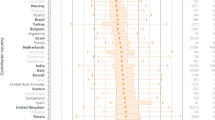Abstract
Background
Obesity has become an epidemic in developing countries including China. The use of bariatric surgery to treat obesity has grown in popularity worldwide, but it is still a new concept in China. This study aims to investigate the trends in bariatric surgery in China.
Methods
An electronic search of the MEDLINE, EMBASE, and Chinese National Knowledge Infrastructure was conducted to select studies for this survey.
Results
A total of 7779 bariatric procedures were reported from 2001 to 2015, most of which (89.2 %) were performed in the most recent 5 years. Further, 70.9 % of all procedures were performed to treat obesity and related comorbidities, defined as metabolic surgery. The data showed 89.4 % of all operations were performed laparoscopically. The absolute number of bariatric surgeries increased 148.7 times in the last 5 years compared to the 2001–2005 period. The percentage of laparoscopic Roux-en-Y gastric bypasses performed increased from 0 to 62.2 %, and the percentage of laparoscopic sleeve gastrectomies from 0 to 12.7 %. The percentage of laparoscopic adjustable gastric bands increased dramatically from 0 to 73.3 % in the 2006–2010 period, but it dropped quickly to 12.9 % in the 2011–2015 period. Most operations (66.7 %) were conducted in the East area, which is the most developed economic region in China. There was limited surgical innovation or original research reported in China.
Conclusions
Bariatric surgery is still at an early stage in China, but is now experiencing an explosive growth. A national registry system needs to be established to record and provide precise data.





Similar content being viewed by others
References
World Health Organization. Obesity and overweight. 2015. Available from: http://www.who.int/mediacentre/factsheets/fs311/en/index.html. Cited 16 Dec. 2015.
Poloz Y, Stambolic V. Obesity and cancer, a case for insulin signaling. Cell Death Dis. 2015;6:e2037.
O’Rourke RW. Obesity and cancer: at the crossroads of cellular metabolism and proliferation. Surg Obes Relat Dis. 2014;10:1208–19.
Hossain P, Kawar B, El Nahas M. Obesity and diabetes in the developing world—a growing challenge. N Engl J Med. 2007;356:213–5.
Kasama K, Mui W, Lee WJ, et al. IFSO-APC consensus statements 2011. Obes Surg. 2012;22:677–84.
Mitka M. Bariatric surgery continues to show benefits for patients with diabetes. JAMA. 2012;307:1901–2.
Wu YF, Cao P, Ge XL, et al. Nursing of the morbidly obese patients treated with laparoscopic vertica lbanded gastroplasty. Acad J Sec Mil Med Univ. 2001;22:478–80. Chinese.
Buchwald H, Williams SE. Bariatric surgery worldwide 2003. Obes Surg. 2004;14:1157–64.
Buchwald H, Oien DM. Metabolic/bariatric surgery Worldwide 2008. Obes Surg. 2009;19:1605–11.
Buchwald H, Oien DM. Metabolic/bariatric surgery worldwide 2011. Obes Surg. 2013;23:427–36.
Angrisani L, Santonicola A, Iovino P, et al. Bariatric Surgery Worldwide 2013. Obes Surg. 2015;25:1822–32.
Lomanto D, Lee WJ, Goel R, et al. Bariatric surgery in Asia in the last 5 years (2005–2009). Obes Surg. 2012;22:502–6.
Li X, Zheng C, Rosenthal RJ. The new concept of bariatric surgery in China—reevaluation of surgical indications and criteria of therapeutic effect of laparoscopy for treatment of obesity. Obes Surg. 2008;18:1180–2.
Fruhbeck G. Bariatric and metabolic surgery: a shift in eligibility and success criteria. Nat Rev Endocrinol. 2015;11:465–77.
Shen X, Zhang X, Bi J, et al. Long-term complications requiring reoperations after laparoscopic adjustable gastric banding: a systematic review. Surg Obes Relat Dis. 2015;11:956–64.
Angrisani L, Cutolo PP, Formisano G, et al. Laparoscopic adjustable gastric banding versus Roux-en-Y gastric bypass: 10-year results of a prospective, randomized trial. Surg Obes Relat Dis. 2013;9:405–13.
Trastulli S, Desiderio J, Guarino S, et al. Laparoscopic sleeve gastrectomy compared with other bariatric surgical procedures: a systematic review of randomized trials. Surg Obes Relat Dis. 2013;9:816–29.
Buwen JP, Kammerer MR, Beekley AC, et al. Laparoscopic sleeve gastrectomy: the rightful gold standard weight loss surgery procedure. Surg Obes Relat Dis. 2015;11:1383–5.
Rawlins L, Rawlins MP, Brown CC, et al. Sleeve gastrectomy: 5-year outcomes of a single institution. Surg Obes Relat Dis. 2013;9:21–5.
Acknowledgments
The study is an internal teamwork from the Gastrointestinal Tract Reconstruction and Metabolic Surgery Association (GIRMSA), West China Hospital, Sichuan University.
Author information
Authors and Affiliations
Corresponding author
Ethics declarations
Conflict of Interest
All authors have no conflicts of interest to declare.
Source of Funding
This study was funded by the National Natural Science, Foundation of China (81502613) and Sichuan Province Science and Technology, Support Program (2014SZ0002-5).
Statement of Human and Animal Rights and Informed Consent
This is a survey in which we do not directly involve human beings or animals but we just analyze the number of bariatric procedures performed in China.
Additional information
Xiao Du and Ru Dai contributed equally to this work.
Rights and permissions
About this article
Cite this article
Du, X., Dai, R., Zhou, Hx. et al. Bariatric Surgery in China: How Is This New Concept Going?. OBES SURG 26, 2906–2912 (2016). https://doi.org/10.1007/s11695-016-2204-2
Published:
Issue Date:
DOI: https://doi.org/10.1007/s11695-016-2204-2




